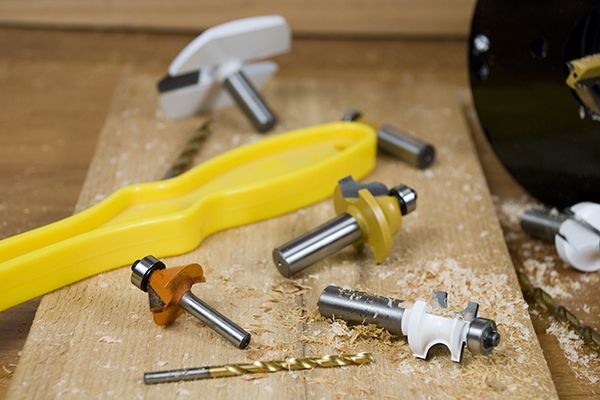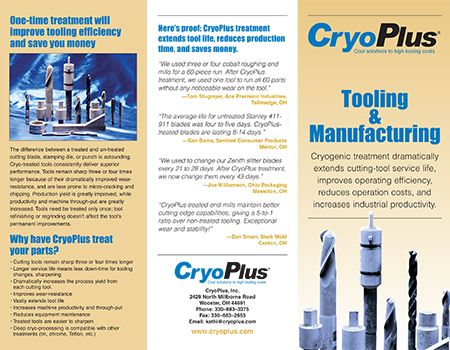
Cutting Tools
While the science of heat treatment is well known and widely understood, the principles of cryogenic tempering remain a mystery to most people in industry. Information regarding this process is full of contradictions and unanswered questions. Until recently, cryogenic processing was viewed as having little value, due to the often brittle nature of the finished product. It is only since the development of computer modeled cooling and reheating process, that the true benefits of cryogenically treated materials have become available to industry and the general public.
Cryogenic treatment can improve the performance and life of your HSS or carbide cutting tools, blades, stamping dies, knives, shears, punches and dies up to 400%! Peak performance and durability is vital to every manufacturing application. The cost and downtime associated with parts replacement has limited the speed of production equipment since the beginning of the industrial age. Proper cryogenic tempering offers impressive gains in terms of tool and component life.
Cryogenic treatment benefits include longer life, less tendency to crack, and this one-time, permanent, and irreversible process means that parts that are reground or re-sharpened do not have to be treated a second time. Also, because up to 66% less material is removed each time, a part can be re-sharpened more times before it is out of tolerance.
Cryogenic processing has been around for many years, but it has been refined using computer-controlled cooling and reheating. Due to recent developments, the cryogenic process for metals is inexpensive. When you consider the increased tool life of up to 400%, it is extremely cost-effective.
View Our Brochure

| Cutting Tools | |||
|---|---|---|---|
| Pounds | Price / Pound | Pounds | Price / Pound |
| 1 - 10 | $17.00 | 90 - 99 | $6.30 |
| 20 - 29 | $15.00 | 100 - 149 | $6.00 |
| 30 - 39 | $13.00 | 150 - 199 | $5.75 |
| 40 - 49 | $10.00 | 200 - 249 | $5.40 |
| 50 - 59 | $9.00 | 250 - 299 | $5.00 |
| 60 - 69 | $8.00 | 300 - 399 | $4.75 |
| 70 - 79 | $7.00 | 400 - 500 | $4.00 |
| 80 - 89 | $6.75 | 500+ | call for quote |
Article: Cryogenic Treatment Enhances Stability for Wire EDM Operation
Before a NASA space shuttle crew takes off into outer space, a series of "goes" contained in a check list must be configured to minimize catastrophic failures, and to maximize the success of the mission and its safe return. In the world of Wire EDM professionals, the mission is very similar to NASA's, in minimizing scrap rate and in maximizing quality (i.e. meeting customer specifications). That is the challenge to each Wire EDM operator and tool designer. Before the Wire EDM operator gives it a "go" (starts his machine cycle), there is a responsible and lengthy check list of concerns, which if not checked off could result in scrapping the work at hand. Some of these concerns are: workpiece perpendicularity, workpiece home coordinate reference, workpiece type (material conductivity factor), etc. Read Full Article (PDF)
Article: Improving Component Wear Performance Through Cryogenic Treatment
Controlling machine wear is a fundamental function of lubrication. By properly specifying lubricant viscosity, using appropriate modifying additives, and controlling contamination, wear rates can be minimized to extend equipment life. However, other influencing factors can still result in less than optimal component wear performance, including equipment loads, design issues, and environmental factors. Cryogenic treatment of tooling steels is a proven technology to increase wear resistance and extend intervals between component replacements for blades, bits, and machining mills. Recent work has also shed light on the effects of cryogenic treatment on bearings, gears and engine components to reduce wear and improve performance. Combining optimized lubrication, correct mechanical configuration, and cryogenic treatment of wearing parts results in the maximum performance of lubricated components, and can significantly extend component life. Read Full Article (PDF)
